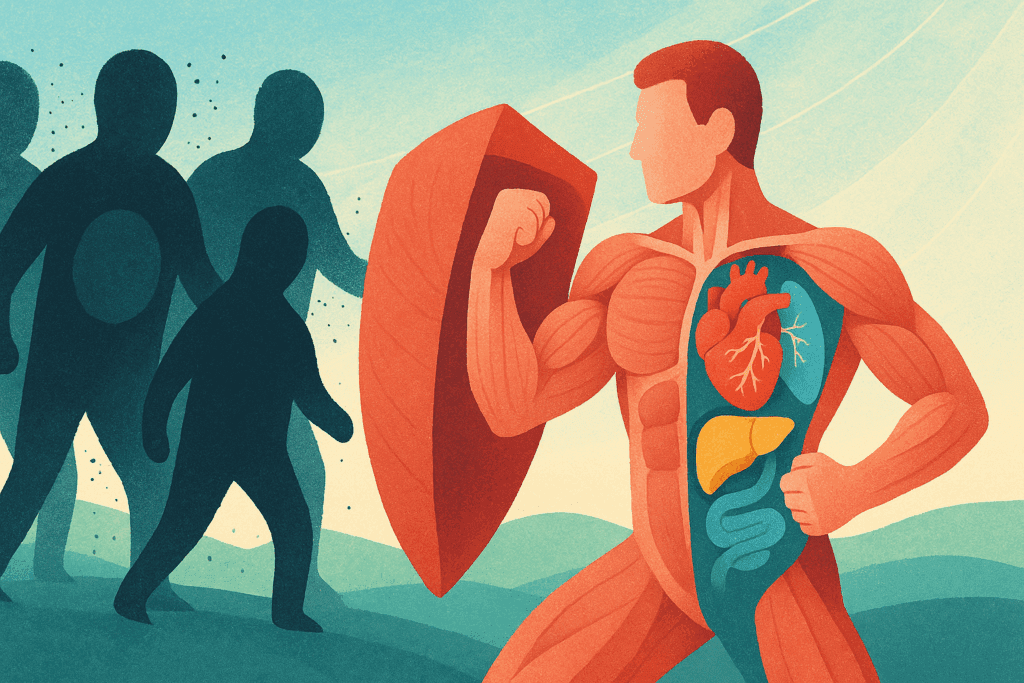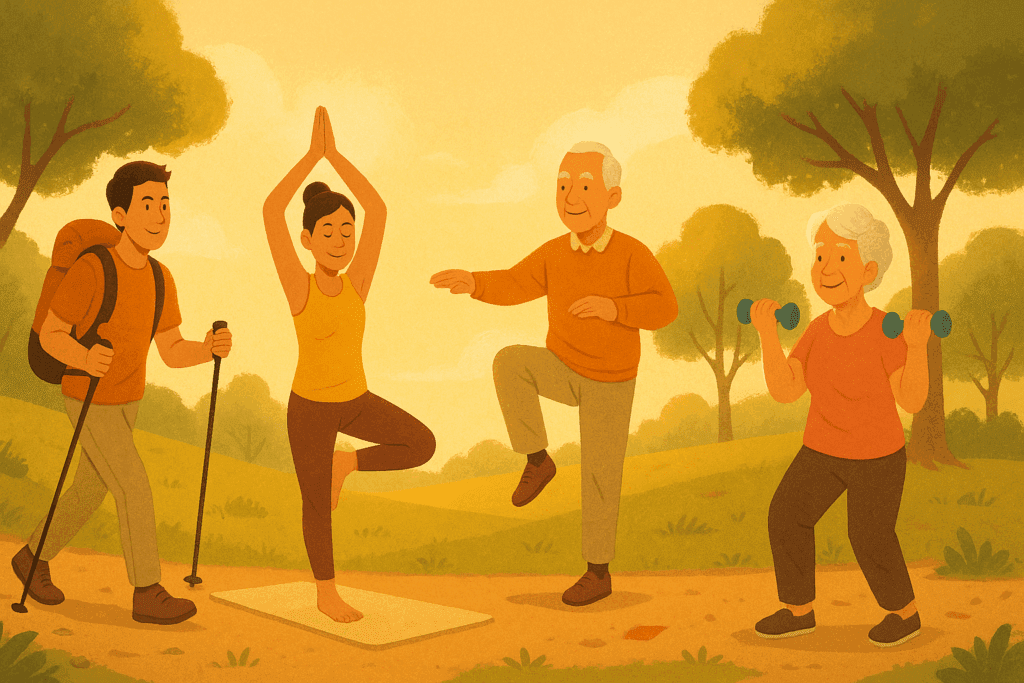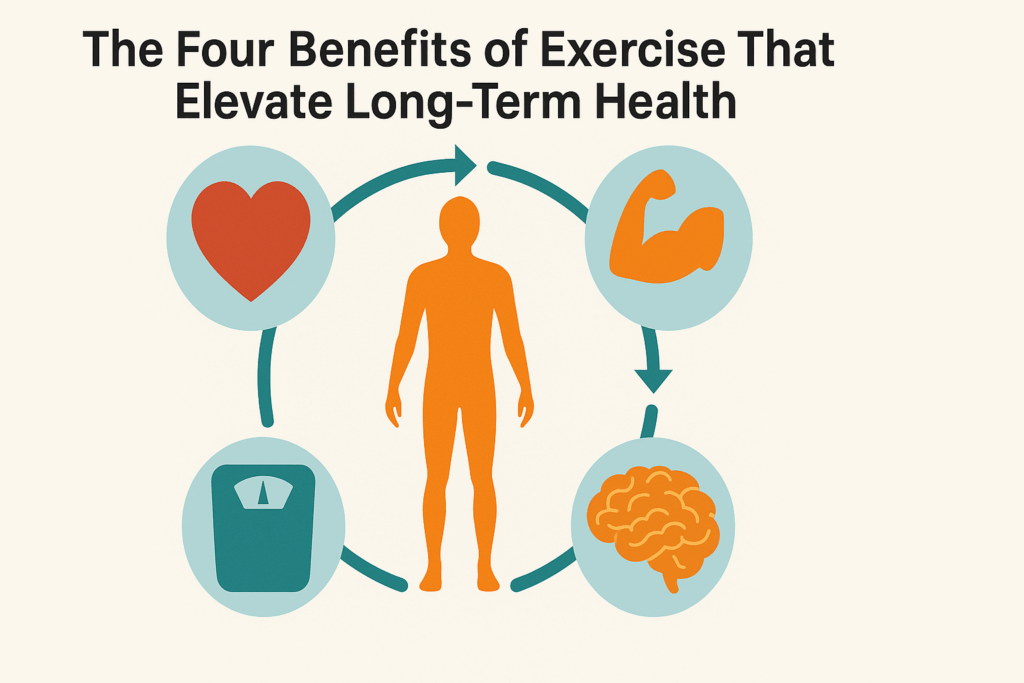Understanding the Vital Connection Between Physical Activities and Overall Health
In the ever-evolving pursuit of a healthier lifestyle, the role of physical activity has never been more critical. Across decades of scientific exploration and health advocacy, one truth remains consistent: physical activities are foundational to human vitality. Engaging in structured movement—whether through cardiovascular exercise, resistance training, or recreational sports—offers transformative benefits that extend far beyond aesthetics or athletic performance. In fact, physical fitness training is intrinsically linked with improved longevity, disease prevention, and cognitive resilience. This intricate relationship between exercise, physical activity, and health underscores the necessity of incorporating consistent movement into daily life.
You may also like: How to Increase Stamina and Endurance Naturally: Smart Training Tips and Nutrition Habits That Support Cardiovascular Fitness
Health professionals consistently recommend regular physical activity because of its multifaceted contributions to wellbeing. The health benefits of regular exercise include improved cardiovascular function, stronger musculoskeletal systems, enhanced metabolic efficiency, and better mental health. By engaging in physical activities that are beneficial to health, individuals not only optimize their physiological capabilities but also build a resilient foundation that supports long-term fitness gains and sustained performance. These effects are not merely anecdotal—they are substantiated by a growing body of research in exercise science, sports medicine, and behavioral health.
Understanding what exercise does for you requires a broader look at how various forms of movement interact with biological processes. For instance, aerobic exercises stimulate cardiovascular endurance, while strength training contributes to bone density and muscle preservation. Yoga and stretching routines support flexibility, balance, and joint health, completing the comprehensive spectrum of physical benefits. By weaving physical activity and fitness into the fabric of daily routines, individuals enhance not only their bodies but also their mental acuity, emotional regulation, and quality of life.

The Positive Effects of Exercise on Physical and Mental Health
The positive effects of exercise reach into virtually every domain of health, from physical stamina to emotional wellbeing. Exercise is good for health not only because it burns calories or builds muscles, but also because it acts as a systemic regulator. Regular movement improves circulation, lowers blood pressure, and modulates inflammatory markers—biological processes that collectively reduce the risk of chronic disease. Furthermore, exercise promotes the release of endorphins and neurotransmitters like dopamine and serotonin, which play a key role in mood stabilization and cognitive performance.
Scientific literature continues to affirm that increasing physical exercise correlates with a lowered incidence of conditions such as type 2 diabetes, cardiovascular disease, and certain cancers. This is where the question, “Does exercise help?” receives a resounding affirmation from the medical community. Not only does it help, but it also acts as a preventive and therapeutic strategy for numerous non-communicable diseases. As researchers further unravel how exercise reduces the risk of disease, we see emerging evidence that even modest improvements in physical activity levels can yield profound health dividends.
In the realm of mental health, physical activity acts as a natural antidepressant. It stimulates the production of brain-derived neurotrophic factor (BDNF), a protein that supports neurogenesis and synaptic plasticity. These mechanisms are particularly crucial in conditions like anxiety and depression, where neuronal communication can become impaired. As a result, many mental health professionals now recommend physical activities as complementary treatments for mood disorders. By fostering this holistic connection between exercise, physical health, and mental wellness, we strengthen the argument that exercise is one of the most accessible, cost-effective, and powerful tools in modern healthcare.

Enhancing Strength and Endurance Through Targeted Physical Training
One of the most measurable outcomes of consistent exercise is improved physical training capacity, which includes gains in strength, stamina, and muscular coordination. Physical fitness training provides the framework for achieving these improvements through structured routines tailored to an individual’s goals, abilities, and health status. Strength training, in particular, serves as a critical component of any comprehensive program. By overloading muscle groups through progressive resistance, the body responds with hypertrophy, increased power, and greater bone mineral density.
Endurance training, often achieved through aerobic activities like running, cycling, or swimming, enhances cardiovascular and respiratory efficiency. These adaptations improve oxygen delivery, lactic acid clearance, and cardiac output, enabling the body to perform at higher intensities for longer durations. Over time, increasing physical exercise in both intensity and volume contributes to the development of long-term stamina. This synergy between strength and endurance cultivates a well-rounded fitness profile that supports both performance enhancement and disease prevention.
Importantly, these gains are not limited to elite athletes or fitness enthusiasts. Adults of all ages can benefit from physical fitness training tailored to their needs. Whether through bodyweight exercises, resistance bands, or free weights, the key lies in consistency and gradual progression. As individuals begin to experience the five physical benefits of exercise—strength, endurance, flexibility, coordination, and balance—they often report increased motivation and confidence in their ability to maintain an active lifestyle. This creates a reinforcing cycle where improved performance begets further commitment to health-enhancing behaviors.

Reducing Disease Risk Through Increased Physical Activity
A critical reason health experts recommend regular physical activity is its proven capacity to mitigate the development of chronic diseases. Epidemiological studies have shown that exercise significantly lowers the risk of conditions such as coronary artery disease, stroke, hypertension, metabolic syndrome, and osteoporosis. This prompts the question: which condition does exercising regularly reduce the risk of developing? The answer is not singular—rather, regular exercise reduces the risk of developing multiple conditions by addressing shared risk factors like systemic inflammation, insulin resistance, and sedentary behavior.
The health benefits of regular exercise include not only physical resilience but also metabolic adaptability. By engaging in exercises and reaping their benefits, individuals improve lipid profiles, enhance glucose metabolism, and support liver function—all factors that contribute to disease prevention. Furthermore, increased exercise helps modulate the immune system, reducing susceptibility to infections and inflammatory diseases. These effects highlight how physical activities that are beneficial to health include mechanisms of protection, regeneration, and optimization.
Beyond disease prevention, physical activity can play a therapeutic role in managing existing conditions. Patients with type 2 diabetes, for example, often experience better glycemic control with regular aerobic and resistance training. Similarly, those with hypertension may see reductions in resting blood pressure after consistent cardiovascular workouts. Understanding what risk factors can exercise reduce becomes increasingly important in clinical practice, where lifestyle interventions are often recommended alongside pharmacological treatments. In this context, exercise is not merely supportive—it is central to holistic care.

Building Physical Health Strengths for Lifelong Wellness
The concept of physical health strengths goes beyond temporary improvements in athletic performance. It encompasses the foundational abilities that support mobility, independence, and quality of life throughout the aging process. Regular exercise and fitness training help preserve these strengths by combating age-related declines in muscle mass, bone density, joint mobility, and cardiovascular capacity. By maintaining these core attributes, individuals are better equipped to navigate the physical demands of everyday life and reduce their risk of injury.
Physical activity and fitness work synergistically to build resilience in the musculoskeletal and neuromuscular systems. Resistance training, for example, can increase the tensile strength of connective tissues, reducing the likelihood of sprains and strains. Likewise, balance and agility drills help improve proprioception, which becomes increasingly important in fall prevention among older adults. These outcomes highlight how physical activities are not only beneficial in youth but remain vital as individuals age.
Functional fitness, which emphasizes exercises that mimic real-life movements, further reinforces this principle. Movements such as squatting, lifting, reaching, and twisting all rely on foundational physical health strengths developed through regular training. As people become more aware of how exercise physical health supports independence, they are more likely to prioritize consistent movement as part of a lifelong wellness strategy. Indeed, how can physical activity or exercise help condition your body? The answer lies in its ability to prepare you for life’s physical demands—today, tomorrow, and decades down the road.

Practical Strategies for Improving Physical Activity in Everyday Life
Improving physical activity doesn’t require drastic lifestyle changes or expensive equipment. It begins with the mindset that movement matters and that every opportunity to be active contributes to a larger health narrative. Whether it’s walking or biking to work, taking the stairs, or engaging in short bursts of bodyweight exercises throughout the day, these small efforts collectively yield measurable gains. The goal is not perfection, but persistence.
Individuals aiming to improve fitness and physical health can start by setting realistic goals and tracking their progress. Fitness trackers, mobile apps, and community programs offer tools to monitor activity levels, encourage accountability, and celebrate milestones. By making activity a social endeavor—such as joining group classes, walking clubs, or sports leagues—people are more likely to stay engaged and motivated. Social reinforcement also helps reinforce the notion that exercise is good for health and can be both enjoyable and sustainable.
For those new to structured routines, starting with activities that align with personal interests increases the likelihood of long-term adherence. Dancing, swimming, hiking, and martial arts are all physical activities that are beneficial to health and offer unique ways to build strength and endurance. The variety ensures that physical activity remains stimulating and that different muscle groups are engaged. As individuals begin to recognize the positive effects of exercise in their own lives, the habit becomes self-reinforcing.

The Four Benefits of Exercise That Elevate Long-Term Health
While the advantages of movement are numerous, the 4 benefits of exercise most commonly emphasized by health experts include improved cardiovascular health, enhanced muscle and bone strength, better mental health, and effective weight management. Each of these elements contributes to a broader understanding of fitness and health, showing how interconnected the body’s systems are and how exercise supports their integration.
Improved cardiovascular health is perhaps the most researched benefit of exercise. Aerobic training helps lower resting heart rate, reduce arterial plaque buildup, and enhance the heart’s pumping efficiency. Enhanced muscle and bone strength come from resistance and weight-bearing activities, which promote protein synthesis and calcium retention. These adaptations are essential not only for physical performance but also for injury prevention.
Better mental health, as discussed earlier, stems from exercise-induced changes in brain chemistry and structure. Physical activity has been shown to reduce symptoms of anxiety, depression, and stress, contributing to emotional resilience and cognitive clarity. Lastly, weight management through exercise involves both caloric expenditure and metabolic regulation, supporting individuals in achieving and maintaining a healthy body composition. By understanding these core benefits and applying them through intentional action, individuals position themselves for lasting wellness and vitality.
Frequently Asked Questions: Physical Activities, Health Benefits, and Long-Term Fitness
1. What are some overlooked physical activities that still offer high health value? While many people focus on high-intensity workouts, everyday physical activities like gardening, raking leaves, or even carrying groceries upstairs can contribute meaningfully to fitness and health. These functional movements engage multiple muscle groups, enhance balance, and help condition your body in real-life scenarios. They’re often more sustainable and easier to integrate into busy routines. These activities may not be part of a formal physical fitness training plan, but their cumulative effect on physical health strengths is significant. For individuals looking to improve physical activity levels without committing to a gym, incorporating such overlooked activities can yield many of the same benefits as more structured routines.
2. How can someone overcome psychological barriers to increasing physical exercise? Mental roadblocks often prevent people from committing to physical training, even when they understand what exercise does for you. Fear of judgment, low self-efficacy, or previous negative experiences can deter participation. One strategy is to reframe exercise as a form of self-care rather than punishment. Mindfulness-based approaches, such as walking meditations or mindful stretching, help bridge the psychological gap between intent and action. As these practices begin to generate the positive effects of exercise—like mood improvement and reduced stress—individuals often experience a shift in mindset that encourages continued progress.
3. What role does community engagement play in improving physical activity adherence? Social support is a powerful tool in promoting fitness and physical health. Community-based programs, like group fitness classes, neighborhood walking clubs, or workplace wellness challenges, provide accountability and motivation. They also foster a sense of belonging, which can be especially important for individuals who struggle with consistency. Research has shown that people are more likely to stick to exercise routines when they engage in physical activities with others. These programs also offer diverse options, which makes it easier to recommend regular activity across different age groups and ability levels.
4. Are there non-physical indicators that suggest physical fitness training is working? Absolutely. While improved strength and stamina are clear signs, there are also subtle, non-physical indicators of progress. Enhanced sleep quality, improved emotional regulation, increased cognitive sharpness, and a stronger immune response are all secondary benefits. These illustrate how the health benefits of regular exercise include more than just visible muscle tone or weight loss. Such outcomes are part of the broader connection between exercise, physical activity and health that is often underappreciated in conventional fitness narratives.
5. What’s the difference between physical health strengths and athletic performance? Physical health strengths refer to foundational capacities like balance, joint stability, and core strength that support everyday movement and reduce injury risk. Athletic performance, on the other hand, focuses on sport-specific metrics like speed, agility, or power. While these two can overlap, especially in trained individuals, they represent different objectives. For most people seeking long-term wellness, cultivating physical health strengths through varied exercises and benefits is more practical and sustainable than chasing performance metrics. By aligning physical activities with health goals rather than competition, individuals gain lifelong value.
6. How does exercise reduce the risk of disease beyond the commonly known mechanisms? Beyond improving blood pressure or lowering cholesterol, regular physical activity influences disease risk by enhancing mitochondrial function, regulating circadian rhythms, and increasing antioxidant capacity. These internal shifts improve the body’s resilience to cellular stress, which is central to disease prevention. In essence, how does exercise reduce the risk of disease? It acts on a cellular level to fortify biological systems. Such changes are vital when addressing what risk factors can exercise reduce, including hormonal imbalances, oxidative stress, and inflammatory load—all key players in the onset of chronic illnesses.
7. Can short bouts of exercise offer the same benefits as longer sessions? Yes, accumulating short bursts of movement throughout the day can lead to substantial health improvements. This approach, known as exercise “snacking,” is especially helpful for people with time constraints. These micro-sessions may include brisk walks, stair climbing, or mobility drills and still yield the five physical benefits of exercise. Studies show that total movement volume matters more than duration per session when it comes to improving physical activity outcomes. In busy environments, this strategy ensures that exercise is beneficial without being overwhelming.
8. How can physical activity or exercise help condition your body for aging? Aging brings natural declines in muscle mass, flexibility, and bone density. Physical fitness training, especially when begun early and maintained consistently, mitigates these effects. Strength training supports musculoskeletal integrity, while balance-focused movements reduce fall risk. Cardiovascular exercises preserve circulatory health and cognitive vitality. When evaluating how can physical activity or exercise help condition your body, it’s helpful to view exercise as a preventive investment—one that preserves autonomy and enhances quality of life as we age.
9. What are the most effective strategies for maintaining motivation to exercise regularly? Maintaining motivation begins with setting personally meaningful goals rather than arbitrary targets. Tracking progress, celebrating small victories, and rotating routines to avoid burnout are all helpful tactics. Visualizing long-term outcomes—such as the ability to travel, play with grandchildren, or avoid medications—can provide strong internal motivation. For many, understanding that physical activities that are beneficial to health include emotional and social gains makes adherence more holistic. It’s not just about movement; it’s about building a lifestyle that supports resilience and vitality.
10. Why do experts continue to recommend regular physical activity despite advancements in medical treatments? Because no medication can replicate the systemic benefits of movement. While drugs may manage symptoms or slow disease progression, exercise offers a proactive path toward prevention and optimization. The 4 benefits of exercise often interact synergistically, influencing everything from neuroplasticity to gut health. As such, experts recommend regularly engaging in movement not only to help fitness but also to enhance total wellbeing. When viewed through this lens, physical activity and fitness aren’t just options—they’re essential components of lifelong health.
Conclusion: Embracing the Full Spectrum of Exercise for Performance and Health
In reflecting on how to boost performance naturally, it becomes clear that the journey begins with consistent, purposeful movement. Physical activities that are beneficial to health include far more than the conventional gym routine—they encompass every step, stretch, and sprint that contributes to the body’s endurance, strength, and adaptability. From managing chronic diseases to improving mood, increasing energy, and building a resilient physique, the health benefits of regular exercise include a wide array of positive outcomes that reach across the lifespan.
Increased exercise doesn’t merely enhance how we move—it redefines how we live. As we gain clarity on what risk factors can exercise reduce and how does exercise reduce the risk of disease, we become more empowered to take control of our health through action. Each decision to engage in physical activity contributes to a cumulative effect that strengthens the body and sharpens the mind. Whether your goal is to help fitness, support physical training, or simply explore the many ways exercise is good for health, the path is accessible, evidence-based, and deeply rewarding.
Ultimately, the intersection of fitness and physical health represents one of the most powerful tools we have for shaping our future. Through sustained commitment and thoughtful application of exercise principles, we can unlock the full spectrum of what exercise does for you—building not only performance and endurance, but a life of balance, capability, and enduring wellbeing.
Was this article helpful? Don’t let it stop with you. Share it right now with someone who needs to see it—whether it’s a friend, a colleague, or your whole network. And if staying ahead on this topic matters to you, subscribe to this publication for the most up-to-date information. You’ll get the latest insights delivered straight to you—no searching, no missing out.

